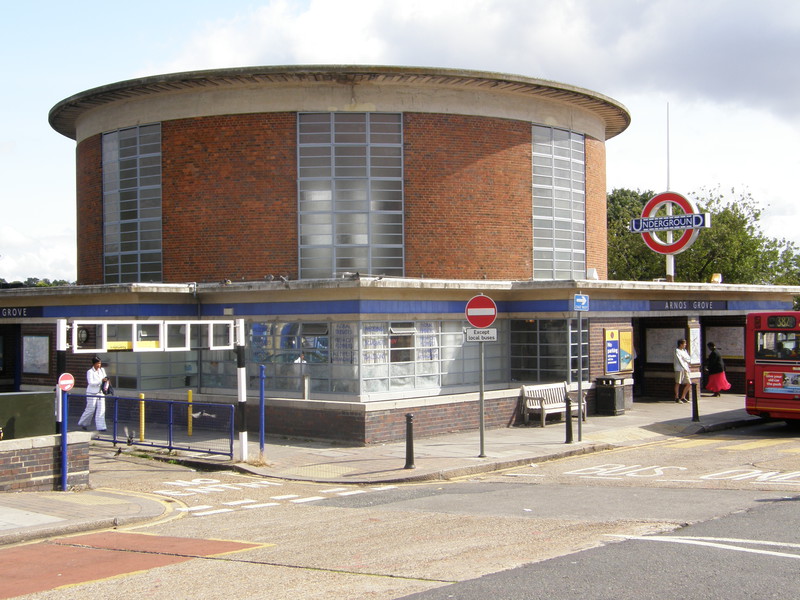
I love reaching the end of the line: it's such a satisfying feeling taking the Tube back through all those stations you've walked through, flying through days of walking in a matter of minutes. But the end of the line is often worth celebrating for the quality of the walking too, as some of the most enjoyable rambling can be found out in zones 5 and 6.
Today not only did I reach the eastern end of the main Piccadilly line, but I walked through some lovely parks, explored some incredibly leafy suburbs, and discovered what must surely be the most coherent collection of Tube station buildings on the entire network. This part of the line is where Charles Holden perfected his 1930s modernist take on station design, and all the stations (with the possible exception of Cockfosters itself) blew me away; I snapped more photos of the stations than the countryside, and quite right too.
I finish off the Piccadilly line tomorrow with the Uxbridge to Acton Town branch, but even if that turns out to be a damp squib, I've already fallen for the Piccadilly's charms. It's great walking all the way from Heathrow to Cockfosters, and I'll be sad when it's all over. Good for you, Piccadilly line.
Bounds Green to Arnos Grove
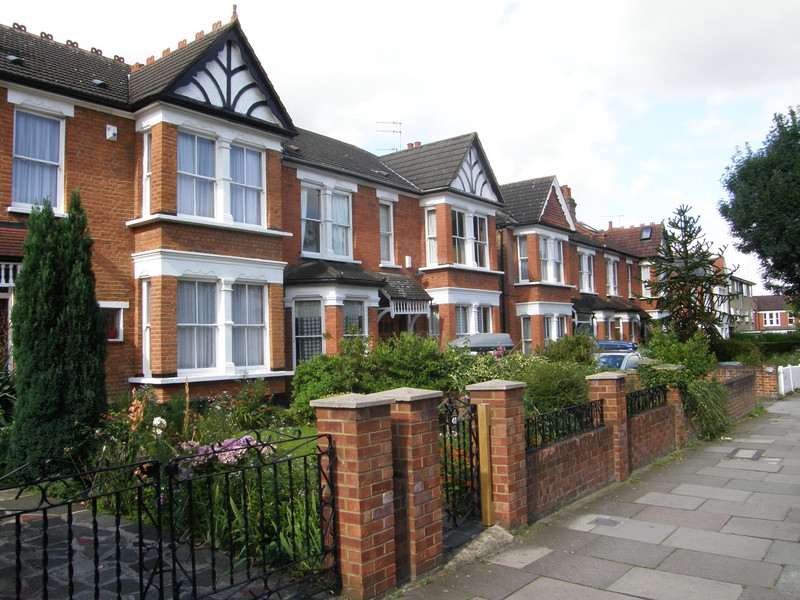
I took a suburban route from Bounds Green to Arnos Grove, and very pleasant it was too. The houses round here generally date from the first half of the 20th century, ranging from Edwardian terraces through to between-the-wars suburban homes, though there is the odd modern block tucked away unobtrusively every now and then. The resulting suburbs feel clean and cared for, and on a Sunday morning the peace is truly impressive. This is the first (and only) tubewalk I've scheduled at the weekend, and the difference is noticeable; I've tried to fit all my tubewalking and writing into normal office hours, to reduce the impact on my real life, but Peta is away this week so I'm cramming as much in as I can, and with weather like this, walking on a Sunday is not only logistically sensible, it's a delight.

It's only out on the North Circular Road that you spot signs of activity, though the amount of traffic today was pretty small compared with most of my run-ins with the A406. Arnos Grove station is a little walk off the orbital, on the right of the road at the top of a small hill, and boy, is it a beautiful sight! It's similar in design to Chiswick Park, which I visited on my walk from Richmond to Ealing Broadway, though it doesn't have a tower like Chiswick Park and is less hemmed in by the roads. The station sports a huge brick and glass drum that's capped by a concrete roof, while the station building proper is a low-rise one-storey structure with yet more glass windows. Of course, it was designed in 1932 by Charles Holden, who created most of the stations on this part of the line, and it's possible that Arnos Grove represents the cleanest and most attractive implementation of his modernist ethos; lots of his stations have tall structures towering above the station, with large windows to let the light into the ticket hall, but sometimes the results are more attractive than at other times, and at Arnos Grove, the balance of clean lines, airy ticket halls and geometric precision is pretty hard to beat. If you like modernism, it's well worth the pilgrimage, but don't take my word for it: a recent article in The Guardian called it the 'king, queen and all princes of a metro station', and it was named as one of our great modern buildings. It's easy to see why.
Arnos Grove to Southgate

A short walk north of the station, at the end of Arnos Road, is Arnos Park, a sweet little open space through which the Pymmes Brook flows on its way southwest to join the River Lea. The river is pretty well hidden behind the undergrowth, which is probably for the best as the park is a popular spot on Sundays with footballers, and you wouldn't want to keep having to fish your ball out of a river. The Pymmes Brook Trail follows the route of the river for about 10 miles, starting at Monken Hadley Common in Barnet and passing this way as it heads for the Lea; if this stretch is anything to go by, it looks like a pleasant trail.
However, the highlight (for me, at least) is the massive railway viaduct along the western edge of the park, which carries the Piccadilly line north towards Southgate. This monstrous brick structure dates from 1933, when the line was extended from Arnos Grove to Oakwood, and it's a solid piece of engineering from between the wars. The trail continues on the other side of the A1003, passing behind houses through some very lush greenery, but you have to turn away from the Pymmes Brook to get to the next station, through yet more pleasant inter-war suburbia that happily has enough variety in its housing to prevent it from getting boring.

Southgate station is in the middle of the appropriately named Southgate Circus, and a circus it is, because Southgate station is absolutely magnificent. As I noted above, architects tend to regard Arnos Grove as the epitome of Charles Holden's modernist designs, but for my own, personal taste, Southgate is the best. It's not so much modernist as futurist Art Deco (which I believe designers call Streamline Moderne, though don't quote me on that), and looks more like a flying saucer from The Jetsons than a Tube station. It's completely circular, with a white concrete roof jutting out above the shops like the brim of a hat, and on top of this hat is a small circular raised section that's lined with windows and topped off with a model of a Tesla coil (which is apparently one of those things that produces lightning in the science lab, but as far as Southgate is concerned, it looks like a stack of four miniature Southgate stations with a big black ball on top). This unwieldy description hardly does the building justice, as the whole thing hangs together in perfect balance, the roof seemingly hovering over the station itself (it is actually supported by a column in the middle of the ticket hall, like a huge concrete umbrella).
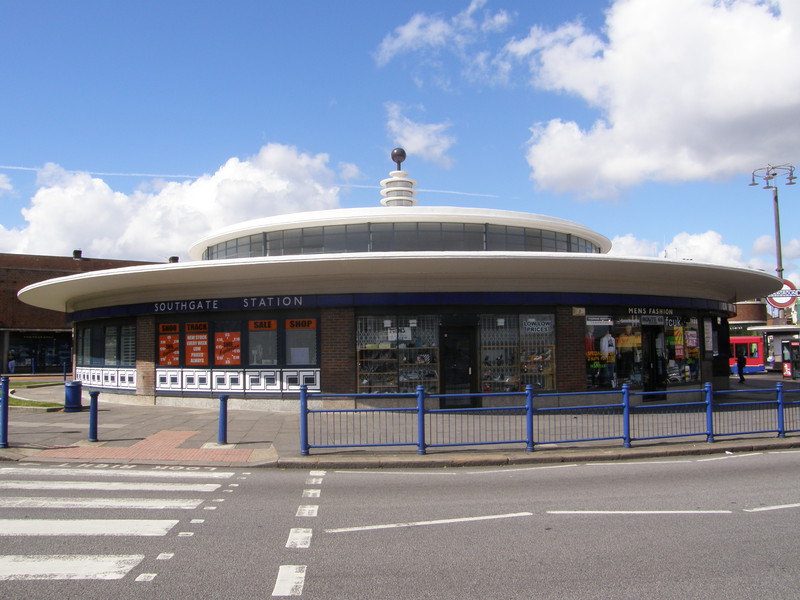
Not only is the station itself quite amazing, but it has a couple of truly futuristic bus shelters, one on each side of the station. Each shelter consists of a circular seat under a round roof, with a large Underground roundel on top, followed by a huge pole that shoots straight up into the sky, exploding into five lamps on a steel hoop like a firework display on a clear November night. There's a similar shelter up the line at Oakwood, but the design complements Southgate's main building perfectly, and I just couldn't stop taking photographs.
As with all the Holden stations on this part of the line, Southgate is Grade II listed, and quite right too. I now have a new contender for my favourite Tube station of all, and it's going to be a hard one to beat.
Southgate to Oakwood
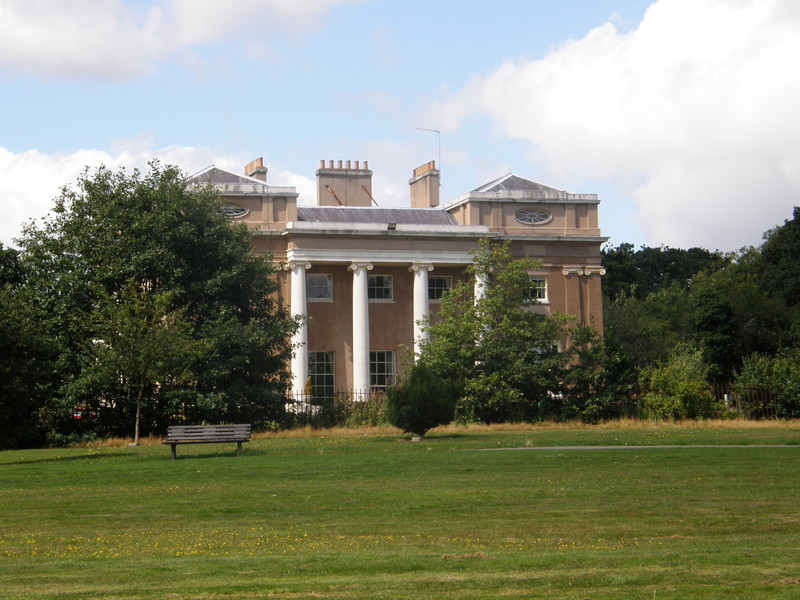
Although it took me a long way off the most direct route, I decided to swing east from Southgate to take in two interesting-looking parks, and I'm glad I made the effort, because the parks round here are very enjoyable, particularly on a sunny weekend when the world and his wife are out for a stroll. The first park, Grovelands Park, is a short walk east from the station, and it's large and pleasantly landscaped, with a boating lake, a pitch-and-putt golf course, good views of Grovelands House and lots of trees. Grovelands House, which was built in 1798, is now the Priory Hospital North London and takes up the northwest corner of the park, though it is understandably off-limits to the public (the Priory Group is best known for its drug-dependency services, which celebrities seem to find as addictive as the substances they're trying to wean themselves off, if the tabloids are anything to go by). The mansion's grounds were landscaped by Humphry Repton, which could explain why it's such an attractive part of the world.

The houses north of the park are, not surprisingly, very pleasant indeed, and it's amazing just how much greenery there is round here; every street is lined with some kind of plant, whether it's hedges, trees, manicured gardens or a combination of all three. I don't know who's responsible for the gardening round here, but whoever it is deserves a big pat on the back, because this has to be one of the most beautiful inter-war suburbs I've ever seen. Walking along The Vale and Oakwood Park Road is like walking through a homes and gardens show, and that takes some effort.
Oakwood Park is north of the lovely suburbs, along a small path between the houses, and again it's a corker. The southern half is fairly wild, with long grass just asking to be lain in, but the northern half is a small golf course, so you're best off walking around the edges, lest you get hit by a stray ball. And you might well get hit, because this is a public golf course, and the players are... well, not that experienced. There are seats on the path round the perimeter, and it's fun watching grandma and granddad taking the grandchildren out for a spot of divot digging; any pretensions you get in expensive golf clubs are missing here, and there's a real feeling that this is a public course and everyone can have a go. Along the northern edge of the course is an avenue of huge poplar trees that were planted over 70 years ago to commemorate the coronation of George VI; they're an impressive sight and make a good spot for a lunch stop.
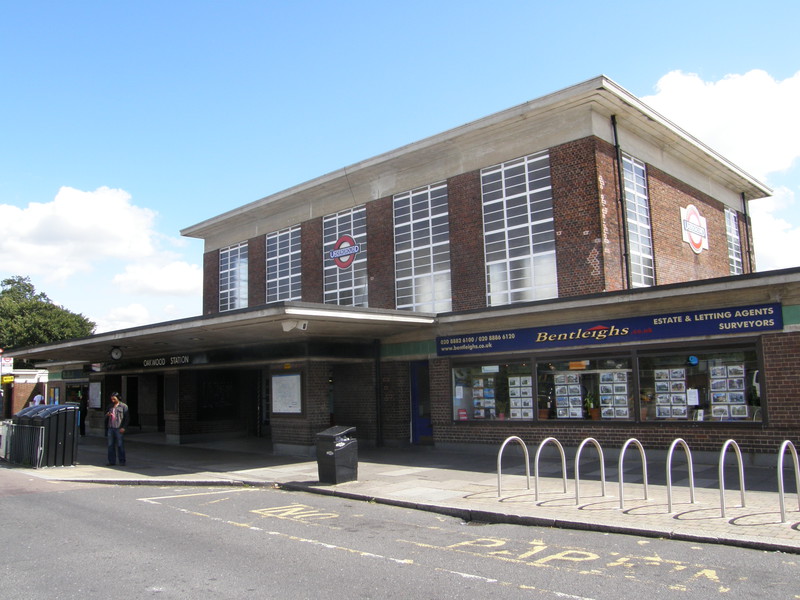
The large suburban houses continue along Prince George Avenue all the way to Oakwood station, another impressive Holden creation. This time the large ticket hall is rectangular, with five vertical sets of windows on the front and back of the block, and roundels on the sides. The design is very similar to that of Acton Town, which I visited on my walk from Richmond to Ealing Broadway, though because there is more space around Oakwood, it's much easier to take in (I found it hard to appreciate the design of Acton Town from the road, but here in Oakwood it really works). Perhaps it's because the width of the rectangular block is about twice its height, giving the structure a pleasing symmetry; or perhaps it's the futuristic shelter out front, which is similar to those at Southgate but with four lights instead of five; but whatever the reason, Oakwood is again a great station, and easily deserves its listed status.
Oakwood to Cockfosters

If you're feeling tired, then it's only a short walk along Westpole Avenue to Cockfosters, but then you'd miss out on the London Loop as it winds through Trent Park, and when the sun is shining, that would be criminal. There's a long and straight road from Oakwood to Trent Park called Snakes Lane, which is a private road belonging to Middlesex University, though as it has a pavement all the way and nobody seems to stop pedestrians from wandering along it, it doesn't appear to be off-limits to the public (though if you had a car, that would be a different story, as the signs are keen to point out).
At the top of the road you can wander through a traffic barrier and straight on towards a large tree trunk lying in the middle of a small green. Don't turn right here, as that will take you towards the main buildings of the university; instead, go straight ahead into the trees, and slightly to your left is a gate that takes you to a cycle track through the woods. This is Trent Park and I first visited this part of the world back in 2003, when I walked day 12 of the London Loop from Cockfosters to Enfield Lock. The park was formed from the grounds of the nearby mansion (which is now part of the university) and its rolling hills and enjoyable lakes are typical English countryside (not surprisingly, parts of it were landscaped by Humphry Repton). The Loop winds its way west through Oak Wood and pops out at a large café, after which it dithers around a bit to get south of the car park before taking you southeast through more woodland and past some fields with great views over the valley. Finally it passes to the south of a cemetery and pops you out right next to the station.
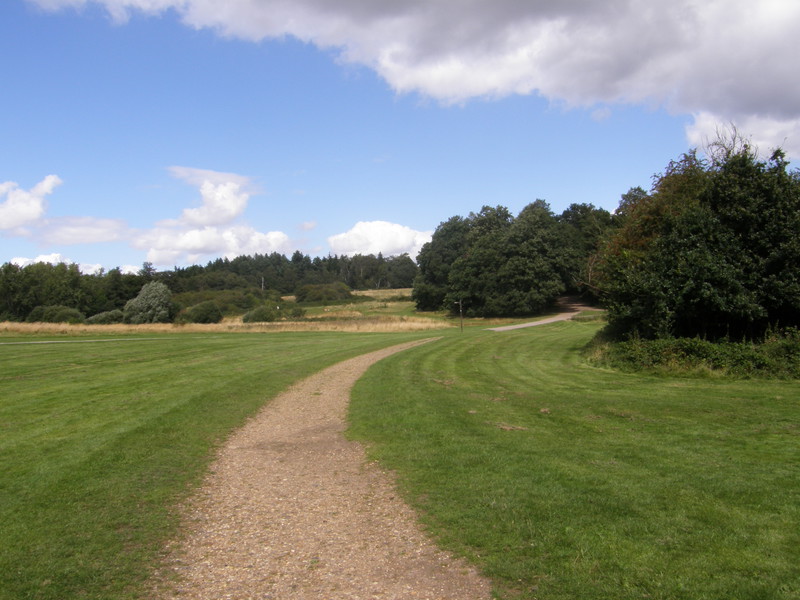
The biggest surprise is that there's a station here at all; Cockfosters station suddenly jumps out at you after all this country walking, and you really don't think you're going to bump into a Tube station in the midst of all this greenery. The suburbia of Cockfosters is mainly to the south and west of here, so this approach from the northeast is particularly rural and it brought back happy memories of the far reaches of the Metropolitan line (though this is only zone 5, believe it or not). The station buildings on the road are pretty modest, with just a single-storey brick building and a couple of small towers sporting roundels, and after the brilliance of Arnos Grove, Southgate and Oakwood, it's a bit of a let-down. However, as with all Holden-designed stations, the inside is at least as interesting as the outside, and the ticket hall and platforms sit pretty under an impressive concrete and glass roof, with Holden's trademark slatted windows letting the light flood in. It's a fitting end to another great section of the Tube, and I can highly recommend this part of the world to anyone who's interested in Tube architecture, countryside, suburbia and gentle, sunny afternoons... which most definitely includes me.